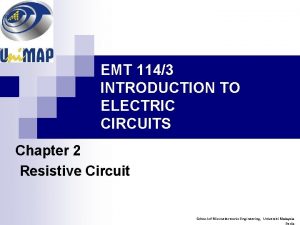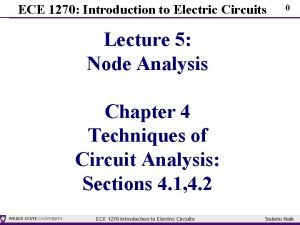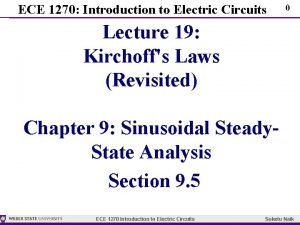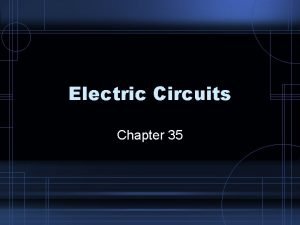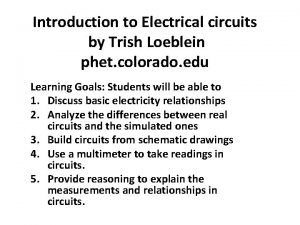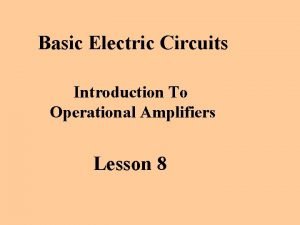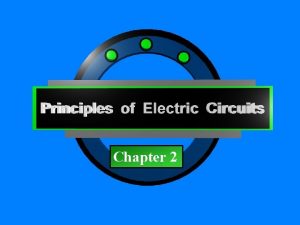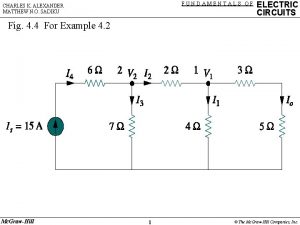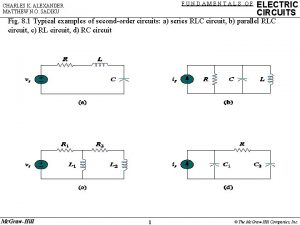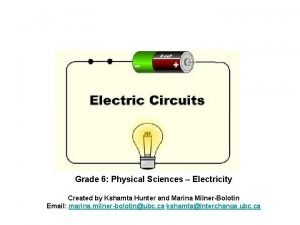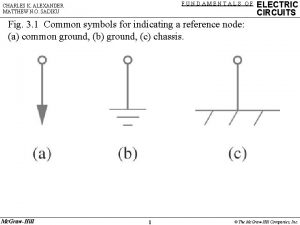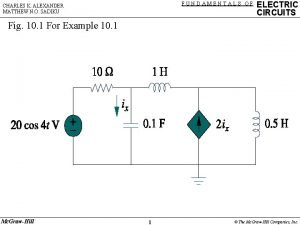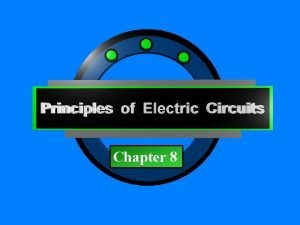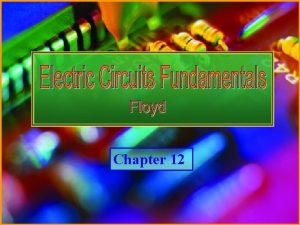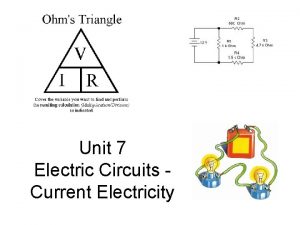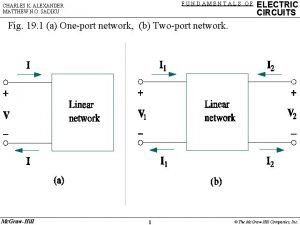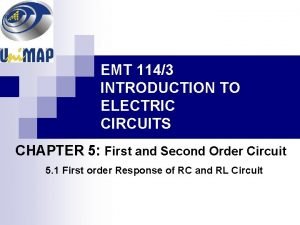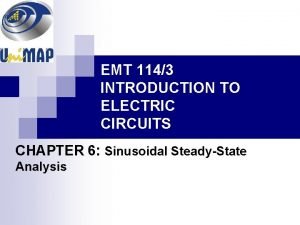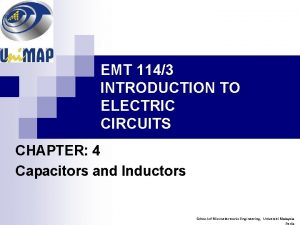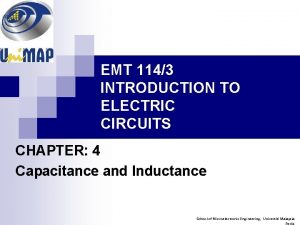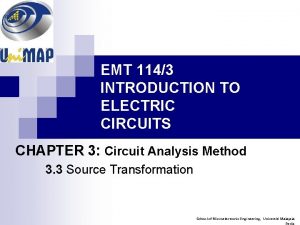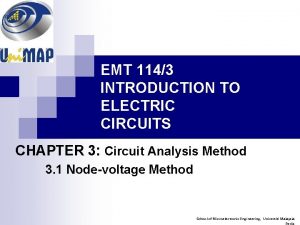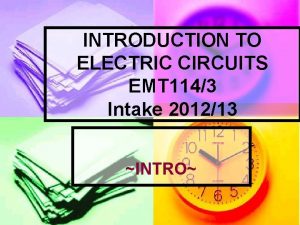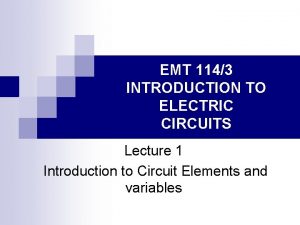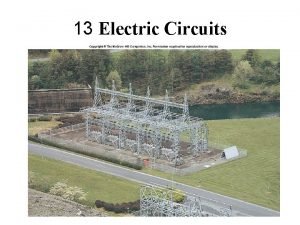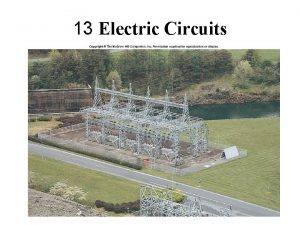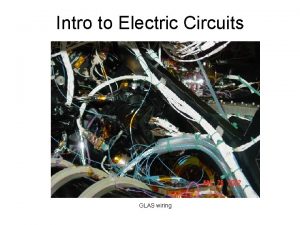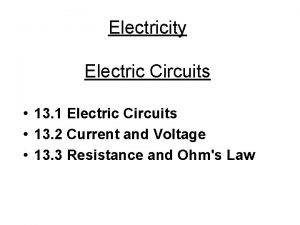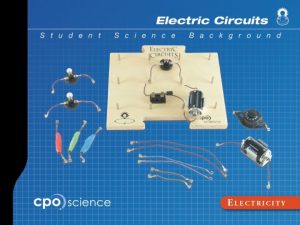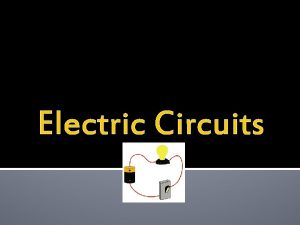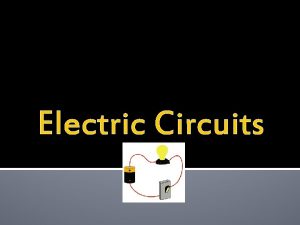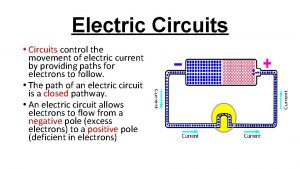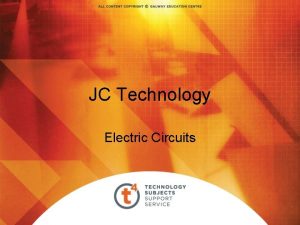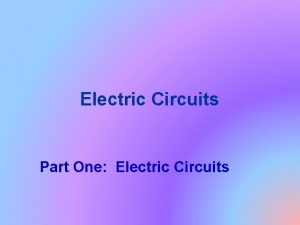EMT 1143 INTRODUCTION TO ELECTRIC CIRCUITS CHAPTER 7































- Slides: 31

EMT 114/3 INTRODUCTION TO ELECTRIC CIRCUITS CHAPTER 7: Power System Circuit School of Microelectronic Engineering, Universiti Malaysia

Chapter Outline 7. 1 7. 2 7. 3 7. 4 7. 5 7. 6 What is a Three-Phase Circuit? Balance Three-Phase Voltages Balance Three-Phase Connection Power in a Balanced System Unbalanced Three-Phase Systems Application – Residential Wiring

7. 1 What is a Three-Phase Circuit? Ø It is a system produced by a generator consisting of three sources having the same amplitude and frequency but of phase with each other by 120°. Three sources with 120° out of phase Four wired system

7. 1 What is a Three-Phase Circuit? Advantages: Ø Most of the electric power is generated and distributed in three-phase. Ø The instantaneous power in a three-phase system can be constant. Ø The amount of power, the three-phase system is more economical than the single-phase. Ø In fact, the amount of wire required for a three-phase system is less than that required for an equivalent singlephase system. Ø Households have single phase mains power supplied. Ø This typically in a three wire form, where two 120 V sources with the same phase are connected in series. Ø This allows for appliances to use either 120 V or 240 V

7. 2 Balance Three-Phase Voltages Ø Three phase voltages are typically produced by a three phase AC generator. Ø A three-phase generator consists of a rotating magnet (rotor) surrounded by a stationary winding (stator). A three-phase generator The generated voltages

7. 2 Balance Three-Phase Voltages Ø Ø Ø Three phase voltage sources can be connected the loads by either three or four wire configurations. The three wire configuration is accomplished by a Delta connected source. Two possible configurations: Three-phase voltage sources: (a) Y-connected ; (b) Δ-connected

7. 2 Balance Three-Phase Voltages Ø Ø Balanced phase voltages are equal in magnitude and are out of phase with each other by 120°. A wye connected source is said to be balanced when the sum of the three voltages is zero: Ø This can only happen if: Ø There are two sequences for the phases: Positive sequence Negative sequence

7. 2 Balance Three-Phase Voltages Example 1 Determine the phase sequence of the set of voltages.

7. 2 Balance Three-Phase Voltages Solution: The voltages can be expressed in phasor form as We notice that Van leads Vcn by 120° and Vcn in turn leads Vbn by 120°. Hence, we have an acb sequence.

7. 2 Balance Three-Phase Voltages Ø Balanced phase voltages are equal in magnitude and are out of phase with each other by 120°. They may also be connected in either a Delta or wye configuration. For a balanced wye connected load: Ø For a balanced delta connected load: Ø Ø Two possible three-phase load configurations: (a) a Y-connected load, (b) a Δ-connected load.

7. 3 Balance Three-Phase Connection • Four possible connections 1. Y-Y connection (Y-connected source with a Y-connected load) 2. Y-Δ connection (Y-connected source with a Δ-connected load) 3. Δ-Δ connection 4. Δ-Y connection

7. 3. 1 Balance Y-Y Connection Ø A balanced Y-Y system is a three-phase system with a balanced Y-connected source and a balanced Y-connected load. Ø We will use the positive sequence for this circuit, meaning the voltages are:

7. 3. 1 Balance Y-Y Connection Ø The line to line voltages are: Ø Thus the magnitude of the line voltages VL is: Ø Where:

7. 3. 1 Balance Y-Y Connection Ø If we apply KVL to each phase, we find the line currents are: Ø From this one can see the line currents add up to zero. Ø This shows that the neutral wire has zero voltage and no current. Thus it can be removed without affecting the system. Ø

7. 3. 1 Balance Y-Y Connection Practice Problem 12. 2 Ø A Y-connected balanced three-phase generator with an impedance of 0. 4 + j 0. 3Ω per phase is connected to a Yconnected balanced load with an impedance of 24 + j 19Ω per phase. The line joining the generator and the load has an impedance of 0. 6 + j 0. 7Ω per phase. Assuming a positive sequence for the source voltages and that find: (a) the line voltages, (b) the line currents.

7. 3. 2 Balance Y-Δ Connection Ø A balanced Y-Δ system is a three-phase system with a balanced Y-connected source and a balanced Δ-connected load. Ø Assuming the positive sequence, the phase voltages are: Ø And the line voltages are:

7. 3. 2 Balance Y-Δ Connection Ø The line voltages are equal to the voltages across the load. Ø From this, we can calculate the phase currents: Ø The line currents can be obtained from the phase currents by applying KCL to nodes A, B, and C Ø Since ICA = IAB -240°: Ø Thus:

7. 3. 2 Balance Y-Δ Connection Practice Problem 12. 3 Ø One line voltage of a balanced Y-connected source is. If the source is connected to a Δconnected load of , find the phase and line currents. Assume the abc sequence.

7. 3. 3 Balance Δ -Δ Connection Ø A balanced Δ-Δ system is a three-phase system with a balanced Δ -connected source and a balanced Δ -connected load.

7. 3. 3 Balance Δ -Δ Connection Ø Assuming a positive sequence, the phase voltages are: Ø If line impedances are insignificant, then the impedance voltages are the same as the phase voltages. Ø Hence the phase currents are: Ø By applying KCL at the nodes A, B, and C: Ø The line current is:

7. 3. 3 Balance Δ -Δ Connection Practice Problem 12. 4 Ø A positive-sequence, balanced Δ-connected source supplies a balanced -connected load. If the impedance per phase of the load is 18 + j 12Ω and find and , find IAB and VAB.

7. 3. 4 Balance Δ -Y Connection Ø A balanced Δ-Y system is a three-phase system with a balanced y-connected source and a balanced y-connected load

7. 3. 4 Balance Δ -Y Connection Ø Applying KVL: Ø Thus: Ø Keeping in mind that Ib lags Ia by 120º, we can solve for the line current:

7. 3. 4 Balance Δ -Y Connection Ø Ø Another way to solve this system is to convert both the source and load back to a Wye-Wye system. The equivalent Wye connected source voltages are:

7. 3. 4 Balance Δ -Y Connection Practice Problem 12. 5 Ø In a balanced Δ -Y circuit, = (12 + j 15) Ω. Calculate the line currents. . and ZY

7. 3 Summary

7. 3. 4 Power in a Balanced System Ø We begin by examining the instantaneous power absorbed by the load. Ø The total instantaneous power in the load is: p= 3 Vp. Ip cos θ Ø This equation is true whether the load is Y- or Δconnected. Ø The average power PP per phase for either the Δ connected load or the Y-connected load is P/3 or PP = Vp. Ip cos θ Ø and the reactive power phase is: QP = Vp. Ip sin θ

7. 3. 4 Power in a Balanced System Ø The apparent power phase is: SP = Vp. Ip Ø The complex power phase is: Sp = Pp + j. Qp = Vp Ip* Where Vp and Ip are the phase voltage and phase current with magnitudes Vp and Ip , respectively. Ø The total average power is the sum of the average powers in the phases:

7. 3. 4 Power in a Balanced System

7. 3. 4 Power in a Balanced System Practice Problem 12. 5 Ø A Y-connected balanced three-phase generator with an impedance of 0. 4 + j 0. 3Ω per phase is connected to a Yconnected balanced load with an impedance of 24 + j 19Ω per phase. The line joining the generator and the load has an impedance of 0. 6 + j 0. 7Ω per phase. Assuming a positive sequence for the source voltages and that find the complex power at the source and at the load.

Ilmu Keikhlasan Kecemerlangan
 Introduction to electric circuits
Introduction to electric circuits Introduction to electric circuits
Introduction to electric circuits Ece
Ece Fundamentals of electric circuits chapter 4 solutions
Fundamentals of electric circuits chapter 4 solutions Electric current
Electric current Conceptual physics chapter 35 electric circuits
Conceptual physics chapter 35 electric circuits Chapter 20 electric circuits
Chapter 20 electric circuits 9
9 Fundamentals of electric circuits chapter 7 solutions
Fundamentals of electric circuits chapter 7 solutions Chapter 35 electric circuits answers
Chapter 35 electric circuits answers Circuits ohm's law worksheet answers
Circuits ohm's law worksheet answers Chapter 35 electric circuits
Chapter 35 electric circuits Current in a parallel circuit
Current in a parallel circuit Chapter 21 electric charge and electric field
Chapter 21 electric charge and electric field Chapter 21 electric charge and electric field
Chapter 21 electric charge and electric field Coulombs units
Coulombs units Units of a charge
Units of a charge Phet circuit construction kit
Phet circuit construction kit Electric circuits equations
Electric circuits equations Electric circuits by james nilsson and susan riedel
Electric circuits by james nilsson and susan riedel Principles of electric circuits
Principles of electric circuits Electrical circuit elements
Electrical circuit elements Sadiku
Sadiku Sadiku
Sadiku Elec 202
Elec 202 Electric circuits grade 6
Electric circuits grade 6 Charles k. alexander matthew n. o. sadiku
Charles k. alexander matthew n. o. sadiku Alexander
Alexander Principles of electric circuits 10th edition answer key
Principles of electric circuits 10th edition answer key Electric circuits fundamentals floyd
Electric circuits fundamentals floyd Physics reference table
Physics reference table Alexander
Alexander
